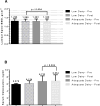Associations among endocrine, inflammatory, and bone markers, body composition and weight loss induced bone loss
- PMID: 24709689
- PMCID: PMC4408214
- DOI: 10.1016/j.bone.2014.03.047
Associations among endocrine, inflammatory, and bone markers, body composition and weight loss induced bone loss
Abstract
Introduction: Weight loss reduces co-morbidities of obesity, but decreases bone mass.
Purpose: Our aims were to (1) determine if adequate dairy intake attenuates weight loss-induced bone loss; (2) evaluate the associations of endocrine, inflammatory and bone markers, anthropometric and other parameters to bone mineral density and content (BMD, BMC) pre- and post-weight loss; and (3) model the contribution of these variables to post weight-loss BMD and BMC.
Methods: Overweight/obese women (BMI: 28-37 kg/m2) were enrolled in an energy reduced (-500 kcal/d; -2092 kJ/d) diet with adequate dairy (AD: 3-4 servings/d; n=25, 32.2±8.8 years) or low dairy (LD: ≤1 serving/d; n=26, 31.7±8.4 years). BMD, BMC and body composition were measured by DXA. Bone markers (CTX, PYD, BAP, OC), endocrine (PTH, vitamin D, leptin, adiponectin, ghrelin, amylin, insulin, GLP-1, PAI-1, HOMA) and inflammatory markers (CRP, IL1-β, IL-6, IL-8, TNF-α, cortisol) were measured in serum or plasma. PA was assessed by accelerometry.
Results: Following weight loss, AD intake resulted in significantly greater (p=0.004) lumbar spine BMD and serum osteocalcin (p=0.004) concentration compared to LD. Pre- and post-body fat was negatively associated with hip and lumbar spine BMC (r=-0.28, p=0.04 to -0.45, p=0.001). Of note were the significant negative associations among bone markers and IL-1β, TNFα and CRP ranging from r = -0.29 (p=0.04) to r = -0.34 (p=0.01); magnitude of associations did not change with weight loss. Adiponectin was negatively related to change in osteocalcin. Factor analysis resulted in 8 pre- and post-weight loss factors. Pre-weight loss factors accounted for 13.7% of the total variance in pre-weight loss hip BMD; post-weight loss factors explained 19.6% of the total variance in post-weight loss hip BMD. None of the factors contributed to the variance in lumbar spine BMD.
Conclusion: AD during weight loss resulted in higher lumbar spine BMD and osteocalcin compared to LD. Significant negative associations were observed between bone and inflammatory markers suggesting that inflammation suppresses bone metabolism. Using factor analysis, 19.6% of total variance in post-weight loss hip BMD could be explained by endocrine, immune, and anthropometric variables, but not lumbar spine BMD.
Keywords: Body composition; Endocrine and inflammatory markers; Physical activity; Weight loss induced bone loss.
Published by Elsevier Inc.
Conflict of interest statement
All authors state they have no additional conflicts of interest to disclose.
Figures

Similar articles
-
Effects of Dietary Protein Quantity on Bone Quantity following Weight Loss: A Systematic Review and Meta-analysis.Adv Nutr. 2019 Nov 1;10(6):1089-1107. doi: 10.1093/advances/nmz058. Adv Nutr. 2019. PMID: 31301138 Free PMC article.
-
The influence of ghrelin, adiponectin, and leptin on bone mineral density in healthy postmenopausal women.J Bone Miner Metab. 2008;26(6):618-23. doi: 10.1007/s00774-008-0861-5. Epub 2008 Nov 1. J Bone Miner Metab. 2008. PMID: 18979162
-
Aged-Related Changes in Body Composition and Association between Body Composition with Bone Mass Density by Body Mass Index in Chinese Han Men over 50-year-old.PLoS One. 2015 Jun 19;10(6):e0130400. doi: 10.1371/journal.pone.0130400. eCollection 2015. PLoS One. 2015. PMID: 26090818 Free PMC article.
-
The role of body mass index, insulin, and adiponectin in the relation between fat distribution and bone mineral density.Calcif Tissue Int. 2010 Feb;86(2):116-25. doi: 10.1007/s00223-009-9319-6. Epub 2009 Dec 3. Calcif Tissue Int. 2010. PMID: 19957167 Free PMC article.
-
Bone, body weight, and weight reduction: what are the concerns?J Nutr. 2006 Jun;136(6):1453-6. doi: 10.1093/jn/136.6.1453. J Nutr. 2006. PMID: 16702302 Free PMC article. Review.
Cited by
-
Effects of Dietary Protein Quantity on Bone Quantity following Weight Loss: A Systematic Review and Meta-analysis.Adv Nutr. 2019 Nov 1;10(6):1089-1107. doi: 10.1093/advances/nmz058. Adv Nutr. 2019. PMID: 31301138 Free PMC article.
-
Obesity and Bone Health: A Complex Relationship.Int J Mol Sci. 2022 Jul 27;23(15):8303. doi: 10.3390/ijms23158303. Int J Mol Sci. 2022. PMID: 35955431 Free PMC article. Review.
-
Number of remaining teeth and its association with socioeconomic status in South Korean adults: Data from the Korean National Health and Nutrition Examination Survey 2012-2013.PLoS One. 2018 May 10;13(5):e0196594. doi: 10.1371/journal.pone.0196594. eCollection 2018. PLoS One. 2018. PMID: 29746489 Free PMC article.
-
Ketogenic diet and β-hydroxybutyrate in osteoporosis: current progress and controversy.Front Nutr. 2025 Jan 23;12:1508695. doi: 10.3389/fnut.2025.1508695. eCollection 2025. Front Nutr. 2025. PMID: 39917743 Free PMC article. Review.
-
In Obesity, HPA Axis Activity Does Not Increase with BMI, but Declines with Aging: A Meta-Analysis of Clinical Studies.PLoS One. 2016 Nov 21;11(11):e0166842. doi: 10.1371/journal.pone.0166842. eCollection 2016. PLoS One. 2016. PMID: 27870910 Free PMC article.
References
-
- NIH Expert Panel on the Identification, Evaluation, and Treatment of Overweight in Adults Clinical guidelines on the identification, evaluation, and treatment of overweight and obesity in adults: executive summary. Expert Panel on the Identification, Evaluation, and Treatment of Overweight in Adults. Am J Clin Nutr. 1998;68:899–917. - PubMed
-
- Shapses SA, Von Thun NL, Heymsfield SB, Ricci TA, Ospina M, Pierson RN, Jr, Stahl T. Bone turnover and density in obese premenopausal women during moderate weight loss and calcium supplementation. J Bone Miner Res. 2011;16:1329–1336. - PubMed
-
- Bowen J, Noakes M, Clifto PM. A high dairy protein, high calcium diet minimizes bone turnover in overweight adults during weight loss. J Nutr. 2004;134:568–573. - PubMed
-
- Rector RS, Loethen J, Ruebel M, Thomas TR, Hinton PS. Serum markers of bone turnover are increased by modest weight loss with or without weight bearing exercise in overweight premenopausal women. Appl Physiol Nutr Metab. 2009;34:933–941. - PubMed
-
- Jensen LB, Kollerup G, Quaade F, Sørensen OH. Bone mineral changes in obese women during a moderate weight loss with and without calcium supplementation. J Bone Miner Res. 2001;16:141–147. - PubMed
Publication types
MeSH terms
Substances
Grants and funding
LinkOut - more resources
Full Text Sources
Other Literature Sources
Medical
Research Materials
Miscellaneous

